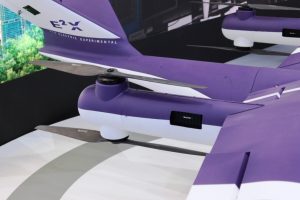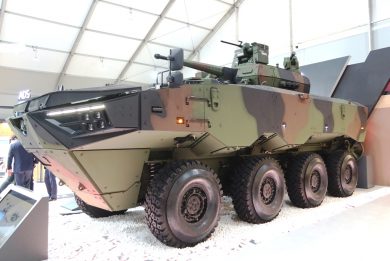
ADEX 2023 – KAI details Advanced Air Vehicle steps forward
At ADEX 2023 Korea Aerospace Industries (KAI) detailed the progresses made by its dual civil/military Advanced Air Vehicle (AAV) programme
The Seoul exhibition allowed updating the status of the Advanced Air Vehicle (AAV) programme, the hybrid VTOL/conventional airframe being developed by the company. The airframe visible at the show was a scaled down 1:4 model of the final air vehicle. It however featured most of the solutions that will be used on the 1:1 prototype. The airframe has a central fuselage that carried high seagull wings and a V tailplane. A fixed tricycle landing gear being used for take-off and landing.

The lift for vertical take-off and landing is provided by a quite peculiar set of propeller/rotors. At the wingtip we find two nacelles with a tiltable rotor; the engine should be in the nacelle itself, which is fitted to the wing and does not rotate, while the forward part rotates, a transmission allowing this, the three-blade propeller being either a rotor providing lift or a propeller providing traction. The same is true for the inner nacelle, which is fitted half way through the wing.

However this protrudes to the rear of the wing, this portion carrying two counter-rotating two-blade rotors that are not tiltable and are used only in vertical flight, balancing the lift provided by the four front propellers when these provide vertical lift. When these are tilted forward becoming real propellers the lift provided by the rear rotors is gradually reduced to nil until they stop in the position providing the least drag, the AVV then flying as a normal aircraft, aerodynamic lift being provided by wings. EDR On-Line understood that the scale model is an all-electric aircraft and that it is being used mostly to evolve and validate the flight control system, the transitional phase being always the most critical in tilt rotors.
The full scale prototype will have a different layout; the increased wingspan, 15 metres considering the tip nacelles, will allow adding one extra nacelle will be added similar to the one existing on the airframe visible at the Seoul exhibition, bringing the number of propellers/rotors to six and the number of VTOL-only rotating rotors to four however with a single rotor EDR On-Line understood. This layout will allow lifting the full-size airframe which maximum take-off mass is forecasted at around 2,500 kg, with a 600 kg payload. The full-size airframe will be 10 metres long and 3.4 metres high, and will be able to carry one pilot and four passengers.

EDR On-Line understood that while electric propulsion will be used initially, which should provide a 150 km range, other forms of propulsion are being considered. One is a hybrid powerplant based on a gas turbine and electric motors, which will come to the cost of noise and the need of cooling, however it would be lighter that the all-electric one and would probably allow reaching a 200-300 km range required by the military. Another development under consideration is the adoption of a retractable landing gear; here too there will be a trade-off between an increase in weight and a considerable reduction in drag when flying horizontally. EDR On-Line also understood that the manned configuration is far from being the only one considered, an unmanned version being high on the priority list, which would allow a much greater part of the payload to be devoted to mission-related equipment of various type.
The Korean military is considering the AAV as an airborne command post, an antiterrorist asset in urban areas, a CASEVAC/MEDEVAC asset, and a reconnaissance asset, while its commercial use is obviously urban air mobility. According to information gathered at ADEX 2023 the first flight should take place in 2027, although other dates for potential flight were aired during the show.
Photos by P. Valpolini



